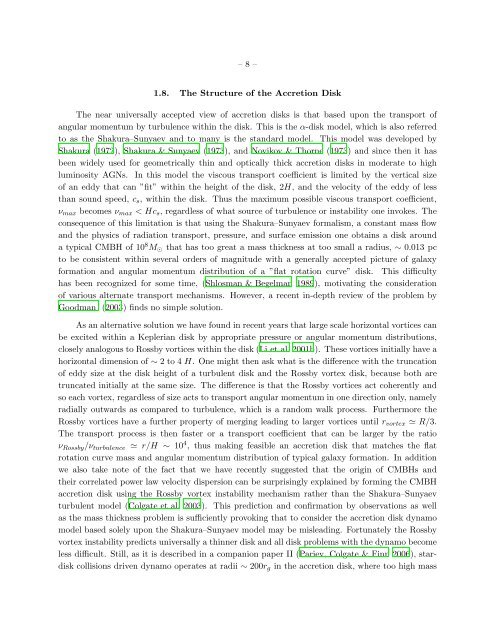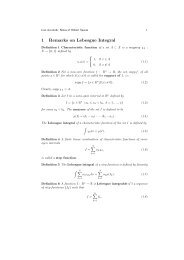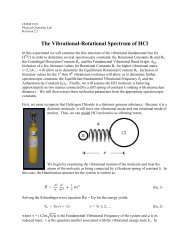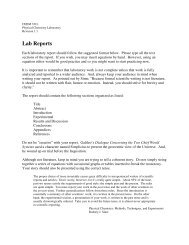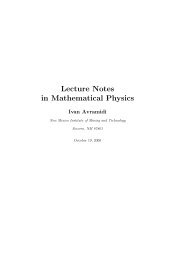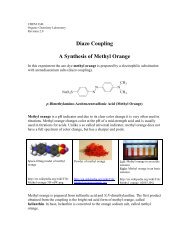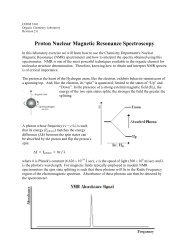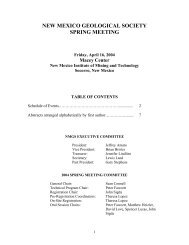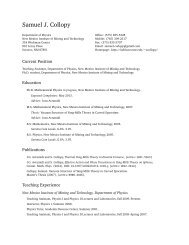A Magnetic α Ï Dynamo in Active Galactic Nuclei Disks - NMT Physics
A Magnetic α Ï Dynamo in Active Galactic Nuclei Disks - NMT Physics
A Magnetic α Ï Dynamo in Active Galactic Nuclei Disks - NMT Physics
Create successful ePaper yourself
Turn your PDF publications into a flip-book with our unique Google optimized e-Paper software.
– 8 –1.8. The Structure of the Accretion DiskThe near universally accepted view of accretion disks is that based upon the transport ofangular momentum by turbulence with<strong>in</strong> the disk. This is the α-disk model, which is also referredto as the Shakura–Sunyaev and to many is the standard model. This model was developed byShakura (1972), Shakura & Sunyaev (1973), and Novikov & Thorne (1973) and s<strong>in</strong>ce then it hasbeen widely used for geometrically th<strong>in</strong> and optically thick accretion disks <strong>in</strong> moderate to highlum<strong>in</strong>osity AGNs. In this model the viscous transport coefficient is limited by the vertical sizeof an eddy that can ”fit” with<strong>in</strong> the height of the disk, 2H, and the velocity of the eddy of lessthan sound speed, c s , with<strong>in</strong> the disk. Thus the maximum possible viscous transport coefficient,ν max becomes ν max < Hc s , regardless of what source of turbulence or <strong>in</strong>stability one <strong>in</strong>vokes. Theconsequence of this limitation is that us<strong>in</strong>g the Shakura–Sunyaev formalism, a constant mass flowand the physics of radiation transport, pressure, and surface emission one obta<strong>in</strong>s a disk arounda typical CMBH of 10 8 M ⊙ that has too great a mass thickness at too small a radius, ∼ 0.013 pcto be consistent with<strong>in</strong> several orders of magnitude with a generally accepted picture of galaxyformation and angular momentum distribution of a ”flat rotation curve” disk. This difficultyhas been recognized for some time, (Shlosman & Begelman 1989), motivat<strong>in</strong>g the considerationof various alternate transport mechanisms. However, a recent <strong>in</strong>-depth review of the problem byGoodman (2003) f<strong>in</strong>ds no simple solution.As an alternative solution we have found <strong>in</strong> recent years that large scale horizontal vortices canbe excited with<strong>in</strong> a Keplerian disk by appropriate pressure or angular momentum distributions,closely analogous to Rossby vortices with<strong>in</strong> the disk (Li et al. 2001b). These vortices <strong>in</strong>itially have ahorizontal dimension of ∼ 2 to 4 H. One might then ask what is the difference with the truncationof eddy size at the disk height of a turbulent disk and the Rossby vortex disk, because both aretruncated <strong>in</strong>itially at the same size. The difference is that the Rossby vortices act coherently andso each vortex, regardless of size acts to transport angular momentum <strong>in</strong> one direction only, namelyradially outwards as compared to turbulence, which is a random walk process. Furthermore theRossby vortices have a further property of merg<strong>in</strong>g lead<strong>in</strong>g to larger vortices until r vortex ≃ R/3.The transport process is then faster or a transport coefficient that can be larger by the ratioν Rossby /ν turbulence ≃ r/H ∼ 10 4 , thus mak<strong>in</strong>g feasible an accretion disk that matches the flatrotation curve mass and angular momentum distribution of typical galaxy formation. In additionwe also take note of the fact that we have recently suggested that the orig<strong>in</strong> of CMBHs andtheir correlated power law velocity dispersion can be surpris<strong>in</strong>gly expla<strong>in</strong>ed by form<strong>in</strong>g the CMBHaccretion disk us<strong>in</strong>g the Rossby vortex <strong>in</strong>stability mechanism rather than the Shakura–Sunyaevturbulent model (Colgate et al. 2003). This prediction and confirmation by observations as wellas the mass thickness problem is sufficiently provok<strong>in</strong>g that to consider the accretion disk dynamomodel based solely upon the Shakura–Sunyaev model may be mislead<strong>in</strong>g. Fortunately the Rossbyvortex <strong>in</strong>stability predicts universally a th<strong>in</strong>ner disk and all disk problems with the dynamo becomeless difficult. Still, as it is described <strong>in</strong> a companion paper II (Pariev, Colgate & F<strong>in</strong>n 2006), stardiskcollisions driven dynamo operates at radii ∼ 200r g <strong>in</strong> the accretion disk, where too high mass


